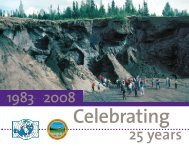Number 20, December 1996 - International Permafrost Association
Number 20, December 1996 - International Permafrost Association
Number 20, December 1996 - International Permafrost Association
- No tags were found...
Create successful ePaper yourself
Turn your PDF publications into a flip-book with our unique Google optimized e-Paper software.
The ICGM permanent buildings and facilities at the fieldsites and the long-term observations offer unique opportunitiesto develop international collaborative research with colleaguesin Almaty. The field camps can also be used for shortexcursions and field courses in mountain geoecology. For additionalinformation contact Igor V. Seversky, Institute of Geography,ICGM, Pushkin st. 99, Almaty, 48010, Kazakstan. Fax:7327 61 8 102; E-mail: ingeo@kawnail.asdc.kz.Submitted by Jerry BrownPERMAFROST IN MONGOLIAMongolian permafrost science has developed since 1950.The Institute of Geography and Geocryology of the MongolianAcademy of Sciences was created in 1962. <strong>Permafrost</strong>distribution has been studied by Mongolian geocryologistsfor the last 34 years. Monographs and papers havebeen published, including <strong>Permafrost</strong> of Mongolia (N. Lonjid,1969), Basic Features of <strong>Permafrost</strong> in Mongolia (N.Sharkhuu, 1975), Seasonal Freezing and Thawing ofGrounds in Mongolia (D. Tumurbaatar, 1975), GeocryologicalConditions of Mongolia (V.F. Gravis et al., 1974),and <strong>Permafrost</strong> in the Kangai and Khubsugul MountainRegion (D. Lubsandavga). <strong>Permafrost</strong> maps compiledinclude a geocryological map of Mongolia on a scale of1 : 1,500,000 based on results of the Mongolian and Russianexpedition of 1971, and a permafrost engineering geologicalmap of the Selenge River basin on a scale of 1:500,000by N. Sharkhuu (1982).The main task of our future permafrost research is tostudy in detail regional regularities of permafrost distributionand development and to provide forecast assessment ofpermafrost conditions in connection with climate changeand management. In order to carry out this task, close contactand collaboration with foreign geocryologists is required,especially those from China, North America, Europe, Russiaand Kazakstan.It is necessary to compile a permafrost map of the Asiancontinent. This work should be organized by the <strong>International</strong><strong>Permafrost</strong> <strong>Association</strong> and Mongolian geocryologistswould participate.Submitted by D. TumurbaatarHIGH ARCTIC FIELD MEETINGAND SYMPOSIUMTen participants from seven countries attended this meetingfrom 7-16 July <strong>1996</strong> on Ellesmere, Cornwallis andAxel Heiberg Islands in the Canadian Arctic. It was organizedby Toni Lewkowin (University of Ottawa) and spon-sored by the IPA Working Group on Periglacial Processesand Environments and the IGU Commission on Frost ActionEnvironments. Logistical support and accommodationwere provided by the Polar Continental Shelf Project (NaturalResources Canada), Department of National Defence,and the Atmospheric Environment Service (EnvironmentCanada). Four days were spent on Ellesmere Island, in theEureka area, at Hot Weather Creek and in the SawtoothRange. Travel was by helicopter and on foot.Landforms and deposits observed included epigeneticice wedges, segregated ice developed in poorly lithified bedrock,ice-wedge polygons, earth hummocks, detachmentslides, debris flows, slushflows, niveo-aeolian deposits andcold-based glaciers. The effects of solifluction were observedat a site where a Rudberg column was excavated after 5 yearsof movement and at an experimental site where the effectsof climate change were being physically modeled. Anotheractive research project concerned the effects of detachmentsliding on rates of slopewash erosion using a series of runoffplots.Eight presentations were given at the symposium atEureka. These discussed chemical and physical weatheringin periglacial areas, landsliding on permafrost terrain, icewedge and sand wedge casts, and periglacial conditions insouthern Germany and the UK during the last glaciation.The planned visit to Expedition Fiord on Axel HeibergIsland was canceled because the landing strip was underwater. An alternate site on the eastern coast at 80°45'N wasvisited (the farthest north point on the trip) and ice-pushfatures examined. In the Resolute area on Cornwallis Island,Kathy Young (York University) showed sites where she isexamining wetland nutrient flows over permafrost. LinkWashburn (University of Washington) described his workon solifluction and patterned ground.Considering that this was a particularly cool summer inthe Queen Elizabeth Islands, the group was fortunate toexperience generally good weather and to be able to seevirtually all that was planned.Submitted by Antoni LewkowiczPERMAFROST DATA WORKSHOPSTwo meetings were organized by the IPA Data and InformationWorking Group and held at the World DataCenter A for Glaciology, Boulder, Colorado, on 15-16 Julyand 12-1 3 <strong>December</strong> <strong>1996</strong>. In July a small working group(R.G. Barry, J. Branson, J. Brown, C. Hanson and A.J.Heginbottom) reviewed the status of the Global GeocryologicalDatabase (GGD), and plans were initiated for preparationof a CD-ROM on permafrost to be distributed at the JuneFrozen Ground




